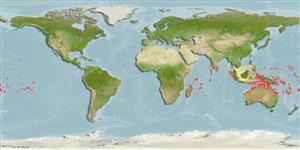Common names from other countries
>
Anguilliformes (Eels and morays) >
Muraenidae (Moray eels) > Uropterygiinae
Etymology: Uropterygius: Greek, oura = tail + Greek pterygion = little wing. Fin (Ref. 45335); kamar: Named for its type locality..
More on authors: McCosker & Randall.
Environment: milieu / climate zone / depth range / distribution range
Ökologie
seewasser riff-verbunden; tiefenbereich 3 - 55 m (Ref. 1602). Tropical; 12°N - 24°S
Indo-Pacific: Sodwana Bay, South Africa. Range extends to Oeno Atoll, north to Marshall Islands; Palau and the southern Marshalls in Micronesia (Ref. 1602).
Size / Gewicht / Alter
Maturity: Lm ? range ? - ? cm
Max length : 37.0 cm TL Männchen/unbestimmt; (Ref. 3257)
Wirbelzahl: 137 - 143. This species occurs in two color morphs; dentition is multiserial.
Lies over coral rubble bottoms (Ref. 1602).
Life cycle and mating behavior
Maturities | Fortpflanzung | Spawnings | Egg(s) | Fecundities | Larven
Castle, P.H.J. and J.E. McCosker, 1986. Muraenidae. p. 165-176. In M.M. Smith and P.C. Heemstra (eds.) Smiths' sea fishes. Springer-Verlag, Berlin. (Ref. 3257)
IUCN Rote Liste Status (Ref. 130435)
CITES (Ref. 128078)
Not Evaluated
Bedrohung für Menschen
Harmless
Nutzung durch Menschen
Tools
Zusatzinformationen
Download XML
Internet Quellen
Estimates based on models
Preferred temperature (Ref.
115969): 24.3 - 28.8, mean 27.5 (based on 366 cells).
Phylogenetic diversity index (Ref.
82804): PD
50 = 0.5000 [Uniqueness, from 0.5 = low to 2.0 = high].
Bayesian length-weight: a=0.00069 (0.00033 - 0.00144), b=3.12 (2.93 - 3.31), in cm Total Length, based on LWR estimates for this (Sub)family-body shape (Ref.
93245).
Trophic level (Ref.
69278): 3.5 ±0.5 se; based on size and trophs of closest relatives
Widerstandsfähigkeit (Ref.
120179): mittel, Verdopplung der Population dauert 1,4 - 4,4 Jahre. (Preliminary K or Fecundity.).
Fishing Vulnerability (Ref.
59153): Low to moderate vulnerability (27 of 100).
